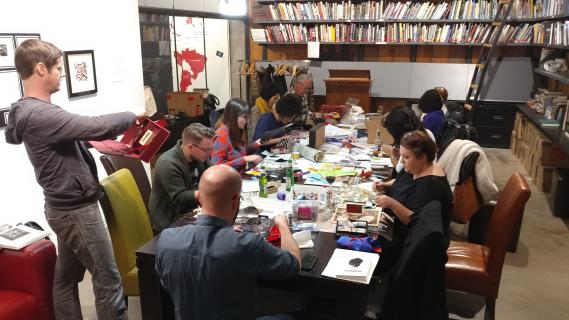
On Monday, November 6, as part of Denver Talks I led a workshop at RedLine Contemporary Art Center on making poem boxes using text from Claudia Rankine’s book Citizen: An American Lyric. We had a great turnout, and in two and a half hours, people who had never heard of poem boxes created some stunning, thoughtful, and highly original works, which will be on display when Rankine gives a free talk at Boettcher Concert Hall on November 15.
We began by discussing the concept of a poem box, which is a project I’ve been working on for the last year: what is it? Poem boxes are like a literary diorama, a sculptural interpretation of text, a 3-D lyric collage, or poetic shadow box. Shadow boxes as an art form began with the Victorians and was elevated by Joseph Cornell, whose work seemed to contain small, beautiful worlds. Now, in our post-modern times, assemblage, collage, and found poetry have been reclaimed as legitimate art forms in our society, where mixing sources is seen as a good thing. (Diversity makes us stronger!)
A wonderful thing about assemblage/poem boxes is that they are cheap to make: you can use 100 percent found objects, and you don't need a lot of space. (I use my dining room table covered by a shower curtain liner I got at the dollar store.) You can make one in a single evening, as we did in the workshop, with many ingredients I gathered on walks around my neighborhood.
Because boxes are usually small enough to hold in your hands, they are inviting. There is some safety in their promise of containment, that things are capable of being contained. This somewhat false assurance is why I always try to include some elements outside of the boxes I make. Which of course conjures the tired phrase "think outside the box," but in this age when personal boundaries and national borders are so prevalent in conversation, in consciousness, it's important to acknowledge that we all work within confines. I like the constraints of working with a box, and with found material, in the same way that I enjoy writing sonnets: working with restrictions, with a specific set of tools (such as a rhyme scheme or using only found objects) forces you to be creative, to conjure associations you may have otherwise not thought of.
After discussing the concept of a poem box we took some time to talk about Citizen, a brilliant book in which Rankine crosses genres from essay to poetry to dialogue to visual art and back again, using everything within her ability to convey what she so urgently must: how it feels to live in a black body, to be a woman of color, moving through modern America. Much of this book's power and authority comes from its unflinching compilation of wrongs: the litany of microaggressions, the stories she tells, the list of names of unarmed black men and women killed by police that would be much longer if the book were published today.
Additionally, Rankine uses visual art to help make her point, heightening the text it accompanies, like the face on an old photograph of a lynching with the hanging bodies removed, or text that’s been altered to the point of distortion. Work that incorporates imagery and text crosses both sides of the brain, can help us think and understand in more comprehensive ways than when just one media is employed.
With that in mind, we set out to begin making poem boxes in the class using some basic guidelines:
- Since we had only a couple hours, think small. A smaller box that focuses on a sentence, fragment, or even a single word instead of a whole page is easier to finish in an evening.
- Imagistic text (text that references something that's visible) is good to use, as it tends to hold some visual element that you can incorporate or echo in your box.
- It helps not to dwell on choices too long. Try to be guided by impulse; move quickly and follow your subconscious. Let go of the idea of perfection, be thoughtful, and trust yourself to do the work.
- Try to capture the emotional mood of the poem in your box sculpture. It doesn't need to be a literal interpretation; can you make the box show or look like how the words from Citizen make you feel?
We talked about ways to integrate text into the boxes, such as collaging phrases photocopied from the book, before the work began. Some people brought their own boxes while others used ones provided by Lighthouse. There were tables of material for use, sourced from cheap or free places: RAFT, ReCreative, thrift stores, ground scores, and my personal collection of assemblage parts and found objects. People used sticks, ribbons, photographs from old advertisements, pinecones, and many other things, including totemic items they had brought to include.
Two hours flew by as people worked on their boxes. Requests for scissors, adhesives, even specific words to collage rang out across a table covered in paper scraps and materials. The RedLine library was filled with a jovial, creative atmosphere: busy but relaxed, a really fun Monday.
Once time was up we took turns showing our work, explaining why the text was chosen and how the items assembled in the box conveyed the idea each person wanted to express. I was truly moved to see such amazing, thoughtful creations that sprang forth in only two hours.
You can see them too! The boxes will be on display when Rankine gives a free talk at Boettcher Concert Hall on November 15.

